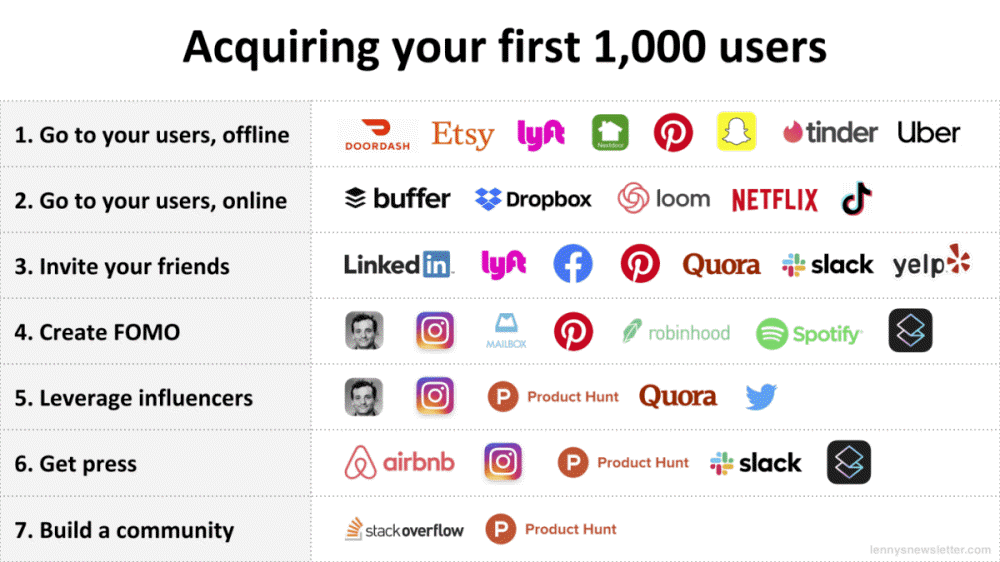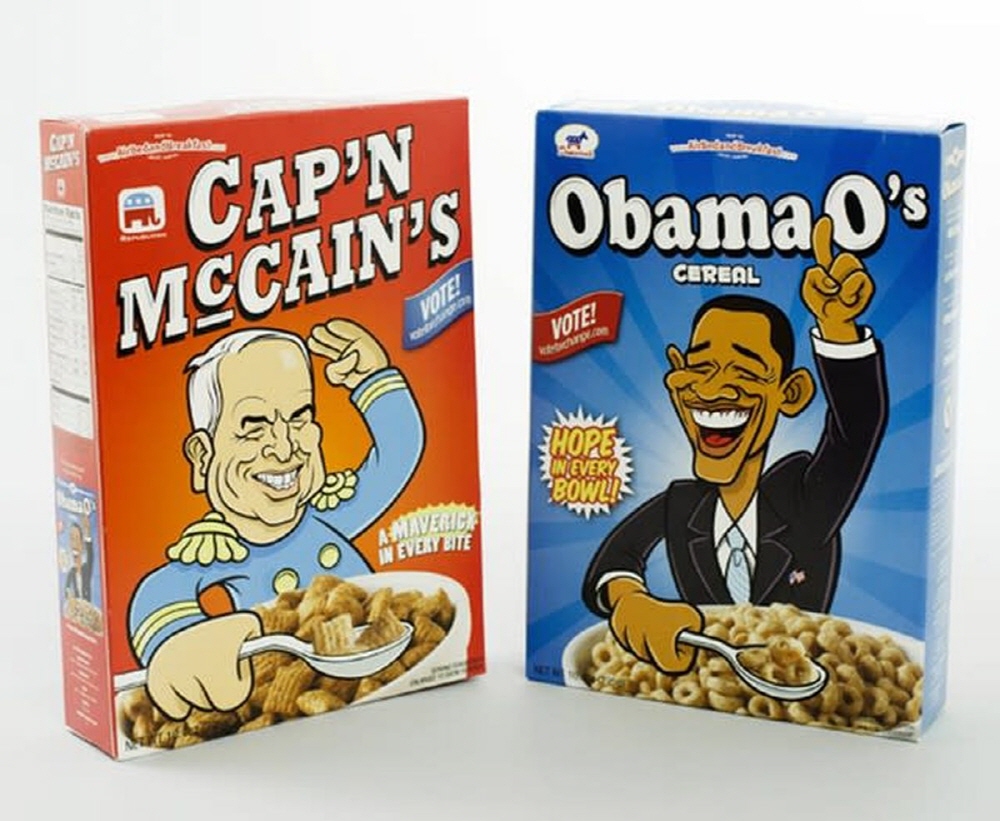
Investor Lenny Rachitsky’s research on how successful web applications or Internet services have secured more than 1,000 users from launch revealed that the majority of services implemented one or three strategies to acquire customers. The strategy for each service can be roughly classified into 7 types, and it is a summary of how to actually acquire customers by service.
According to this, seven strategies support the initial growth of all services. Most services acquire initial users with one of these strategies and succeed with at most three strategies. Looking at seven things, the first is to promote at the place where the target meets offline, the next is to promote at the place where the target meets online, the third is to invite friends, and the fourth is to use FOMO (Fear of missing out) , The fifth is the use of influence, the sixth is media publication, and the seventh is the use of private communities.
Looking back one by one, the first is to promote in places where targets gather offline. Food delivery service DoorDash began as a PDF site for restaurant menus located in Palo Alto. The development team printed a large number of flyers with a shipping fee of $6 and placed them all over Stanford University. Through this, the number of users has steadily increased.
The matching app Tinder conducted marketing on college campuses for college students. Tinder was able to expand the number of users for the University of California social club, focusing on knowing if the other person is interested in him or her.
The photo-sharing app Snapchat, founder Evan Spiegel, has consistently promoted by going to the shopping mall and handing out flyers or giving passers-by a 1:1 Snapchat practice. He even downloaded Snapchat to the other’s smartphone. In How to Turn Down a Billion Dollars (The Snapchat Story), a book about Snapchat’s history, he said he was thinking of doing whatever it takes to get customers.
The development team of Etsy, a handicraft product e-commerce company, went to all craft fairs in the United States to recruit users to become Etsy sellers. Collecting sellers such as exhibiting at a craft fair resulted in the effect of attracting buyers, who are also fans of the seller, to Etsy.
The Uber development team, a vehicle-sharing service, increased the number of users by distributing app recommendation codes at stations with high demand for dispatch services, and the Lyft development team promoted the company rather than individual users. All of the development team gathered contact information for small startups, delivered free San Francisco popular ice cream for each company, and announced the name Rift.
Ben Silverman, one of the founders of the image-sharing site Pinterest, said he went to the Apple Store and turned every PC screen into a Pinterest page that made people think Pinterest was really trendy.
The second is to promote it in places where targets gather online. Dropbox founder Drew Houston released a brief video introducing Dropbox through Hacker News in April 2007. This video triggered Dropbox to successfully acquire users.
The secret to the success of TikTok, a short video sharing service, was in its long application program name. Shortly after TikTok appeared, instead of the name TikTok, it is still a long name to make awesome music videos using all kinds of effects for’make awesome music videos with all kinds of effects for Instagram, Facebook Messenger’. If you use a known application program name, it is easy to hit in search engines, so you can get a lot of users.
Netflix says its employees pretend to be home theater enthusiasts and movie fans to join the movie fan community, gaining trust from key members over the course of several months, and slowly taking time to promote Netflix.
Buffer, which secured more than 100,000 users in 9 months, conducted a guest blog to contribute to other blogs and promoted it. More than 150 guest blogs steadily increased user interest as the number increased and the number of users increased. Of course, founder Leo Widrich also said it took a little while before we could find a suitable guest blog post frequency in an interview.
The third is inviting friends. In the case of Slack, the team communication tool, founder Stuart Butterfield asked a friend who works for a third party to use the application and asked for feedback. As he wrote, he explained that he increased not only users but also feedback.
Immediately after launch, Facebook increased users by letting friends on the development team use the service. First, Facebook was promoted on an e-mail list of 300 people, and Facebook spread from person to person, gaining more than 1,200 users within 24 hours of the mailing list announcement.
LinkedIn, using the network of founder Dir Hoffman, brought only successful friends to use LinkedIn, gaining user acquisition and image enhancement right after launch.
The fourth is to use FOMO. The use of FOMO refers to acquiring users in the form of piggybacking around and inducing anxiety that it is only me who is not using the service. Instagram founder Kevin Systrom said that the biggest thing in his lecture was that the Instagram prototype was tested by a large number of followers on Twitter. Influencers shared it on Twitter and released Instagram. He waited for and explained that it led to good results on the actual release date.
Mailbox, an email management app, was once so popular that more than 700,000 users waited for registration. On the surface, the mailbox side is a structure to manage user demand, but it is also a marketing strategy that uses the fact that there are many users as promotional materials. Mailbox service ended on February 26, 2016 for reference.
Spotify operated as an invitation to register new users right after its launch. Choosing the invitation system not only helped manage the level of Spotify growth, but also spread word of mouth from users to users.
The fifth is using influence. The founders of Product Hunt approached designers with a large number of Twitter followers as first-time users. It was used to establish the artistry of Product Hunt by asking many users to create content that not only could advertise, but that anyone could see it.
The sixth is media contact. Instagram, not a PR company, directly contacted the media and requested a lot of coverage. At first, I hesitated, but I contacted the New York Times, and not only was interested in Instagram, but also a reporter covered it, and at about the same time as the release in October 2010, reporters reported that the server had access enough to be hit hard.
The turning point for Airbnb was the 2008 Democratic National Congress in Denver. At the time, the presidential candidate, Barack Obama, received high attention and more than four times more people participated than before, resulting in a massive shortage of accommodation facilities. Airbnb caught the eye of tired officials and Democratic supporters looking for accommodation, and users could expand. However, the expansion of Airbnb usage lasted only about a week. Afterwards, the founders said they continued to run their business by selling breakfast cereals designed for Obama and John McCain’s faces on an auction site.

Seventh is the use of private communities. Product Hunt founder Ryan Hoover said in an interview that when the finished version of Product Hunt was completed, the people who helped them were emailed a link to the finished version to actually use it. On this day, it secured 30 users, and after a week it increased to nearly 100.
The founders of Stack Overflow, a programming technology Q&A site, had a large community of online followers. They didn’t want to start StackOverflow with nothing, and they appealed for community member beta participation and released StackOverflow with some content gathered.
These seven methods are the only way to secure the first 1,000 users. It is worth remembering that the strategy for acquiring the first 1,000 customers is very different from the strategy for acquiring 10,000 customers. Related information can be found here .


















Add comment